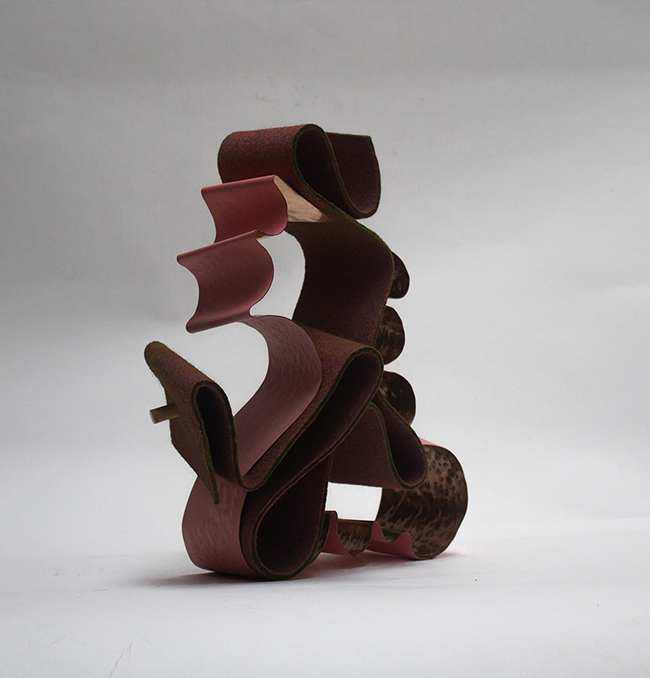Louise McRae’s artistic journey began on the isolated coasts of West New Zealand. Growing up in this remote landscape, she spent her days riding along the coast, accompanied by birds and her vivid imagination. These early experiences laid the foundation for her unique artistic vision, one deeply rooted in nature and the dynamic interplay of materials.

Years later, McRae found herself drawn to the world of art, captivated by the ways materials behave and transform. Her interest lies in the moments when materials fail or surprise, revealing new potentials and meanings. This fascination with materiality informs her work, which blurs the boundaries between making and living. For McRae, the process of creation is a reflection of life itself—a dance between curiosity, vulnerability, and the pursuit of wisdom.
One of McRae’s works is “Pink Landscape,” part of her “Landscape Creatures” series. This piece combines copper, felt, wood, and acrylic, exploring how spending time in a particular landscape influences our outlook and character. The series invites viewers to ponder the silent connections we form with the land and how these connections subtly shape our perceptions and emotions.
Artist Andrea Du Chattener remarked on the complexity and ambiguity of McRae’s materials, noting the tension between similarity and difference that invites closer inspection. The interplay of felt and aluminum, for instance, creates a tactile experience that compels viewers to touch and explore.
McRae’s recent exhibition, “Hurricane Lizards and Plastic Squid,” exemplifies her fluid approach to art and sculpture. The title, borrowed from Thor Hanson’s book on climate change adaptation, reflects her interest in how materials and forms evolve in response to changing environments. Hanson’s book highlights how species like Anole lizards and Humboldt squid adapt to new conditions, a theme that resonates with McRae’s work. Hanson himself praised McRae’s work as “gorgeous” and “fascinating,” mirroring the stories of adaptation he explores in his book.
In “Hurricane Lizards and Plastic Squid,” McRae transforms everyday materials into unexpected forms, creating a sense of wonder and intrigue. Her use of brightly colored felt and warm metals like brass, copper, and alloy challenges traditional notions of sculpture. These materials, typically used for their functional properties, are reimagined in McRae’s hands, taking on new life and meaning.
McRae’s approach has been likened to punk art for its irreverence and defiance of conventional expectations. Much like the Surrealists, she creates tensions between materials, eliciting both physical and emotional responses from viewers. Her work recalls the assemblages of Rosalie Gascoigne, the bricolage of Cubism, and the idiosyncratic collages of Dada artists like Kurt Schwitters and Hannah Höch.
One of McRae’s favorite designers, Issey Miyake, influences her work significantly. Miyake’s innovative use of fabric and drapery can be seen in McRae’s sculptural pieces, which often resemble the pleats of a Japanese kimono. Works like “Naturgemälde” pay homage to Miyake, blending tiny restrained pleats with larger, luxurious folds.
Humor and play are powerful components of McRae’s practice. By deconstructing classical forms of sculpture and painting, she invites viewers to see the world from a different perspective. This playful approach is radical and destabilizing, challenging our sense of order and encouraging us to embrace uncertainty. As Sarah Lucas, another artist who uses humor in her work, once said, “When humor happens, things get good, less depressing.”
McRae’s work is characterized by its maximalist style and vibrant color palette. She uses materials like felt, brass, and copper in unexpected ways, creating pieces that are both opulent and grounded. These materials, traditionally associated with jewelry making, are transformed into looping, folding forms that burst with energy and life.
In pieces like “Un-Monumental,” McRae’s work takes on a corporeal quality, with materials bending and rolling like the human body. The contrast between hard and soft, stiff and floppy, and matte and shiny textures creates a dynamic visual experience that challenges our perceptions.
Ultimately, Louise McRae’s work is about adaptation and transformation. Just as hurricane lizards and plastic squid evolve to survive in changing environments, McRae’s art challenges us to evolve and adapt to a world in constant flux. Her work inspires us to see materials—and life itself—in new and unexpected ways, encouraging us to embrace the beauty and complexity of change.
Credit: The writing about ‘Hurricane Lizards and Plastic Squid’ originated from Claire Ulenberg.

